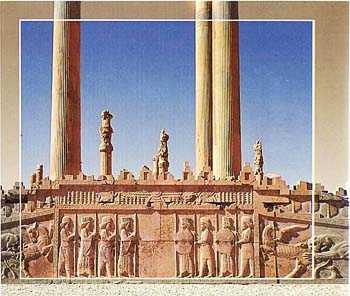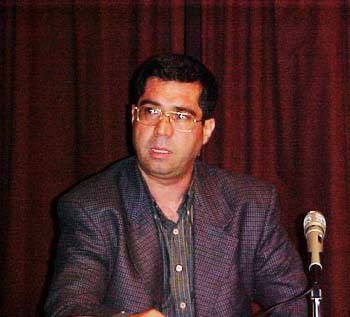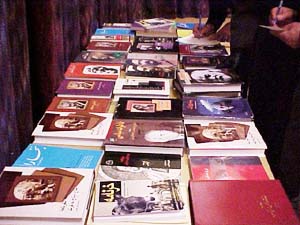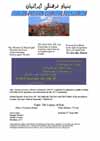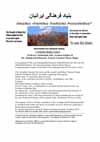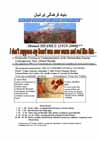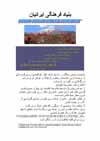Cultural activities and promotion of Science for community
A. Science without frontiers
Science is intimately integrated with
the whole social structure and cultural tradition. They mutually support one other-only in
certain types of society can science flourish, and conversely without a
continuous and healthy development and application of science such a society
can not function properly.
Parsons, Talcott
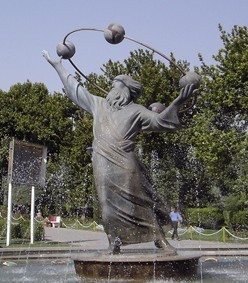
Statue of Biruni, the Iranian Medieval
Scientist, Laleh Park, Tehran,
Iran
B. Persian Poetry Nights in Canberra
Prior to
formally establishing the �Iranian-Persian Cultural Foundation�, the founding
members of the IPCF had been involved for several years in different aspects of
community activities. In fact one might say that those activities inspired
the founders of IPCF to establish such foundation.
Hashem Etminan as a
scientist himself had always been an advocate of inarguable significance
of science, technology and their role in our daily life and society in
general.
Besides he has always been fond
of human science from his early life. Hashem Etminan has been fortunate
that his spouse, Mina is equally and particularly interested in the latter
subject matter. She has been supportive to her husband in realization of
these ideas as part of their duties to providing services to the community.
A. Science without
frontiers
The whole of science is nothing more
than a refinement of everyday thinking.
Albert Einstein
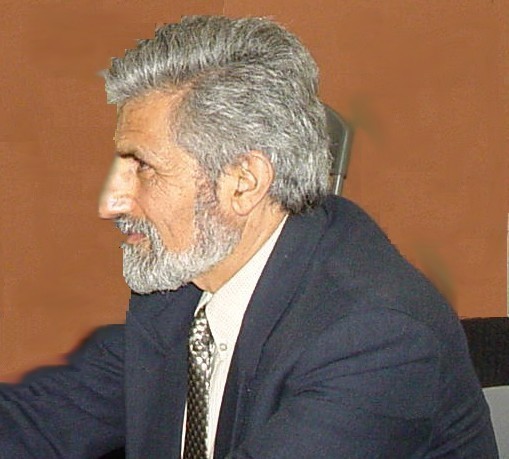
Examples of some of the
activities of Dr Hashem Etminan in this direction are as follows:
1986-Hashem Etminan, Speech
Australian-French Association for
Science and Technology (ACT) Incorporated, Canberra.
Laser Raman
Microprobe- State- of- the- Art technique& its wide
range of applications
http://www.afas.org.au/act/index.htm
www.ambafrance-au.org
1994- Hashem Etminan, Speech
Iran's contribution to the world output in
science and technology
A review of past, present and a vision
for the future
Speech delivered at "the friends of Science
group, Canberra, ACT, Australia
1994- Hashem Etminan, Speech
Speech recorded and broadcast in
Iranian National Broadcasting Organization (Science program,
voice of Iran, Tehran, Iran).
Significance
of applied science and its impact on well being of society.
Example:
Discovery of Songun porphyry copper deposit in Eastern Azarbaijan, Iran
by Dr Hashem Etminan in 1977.
http://www.ngdir.ir/publications/publicationDetail.asp?PID=36
1995- Hashem Etminan, Speech
Geology beyond 2000
advances
in science and technology applied
in earth
sciences and exploration for
mineral
resources
Speech
delivered in Atomic Energy Organization, Iran.
1995- Hashem Etminan, Speech
Speech delivered in U.S. Geological Survey. USGS
National Centre,Reston,VA,USA
http://www.usgs.gov/ask/#hq
Biomarkers
in fluid inclusions
State-of-the-Art technique
Towards a better understanding of oil migration and carbonate
hosted lead-zinc deposits
B. Persian Poetry Nights in Canberra
In April 1995, Mina and Hashem Etminan commenced Persian Poetry Nights in
Canberra .
The functions were held in their residence on the first Saturday of each
month.
The poetry nights started only with few numbers of close friends who were
interested in Persian poetry and in Iranian literature in general. The
Persian poetry nights gradually increased to a number of participants that
the Etminan residence was no longer adequate for receiving all interested
people for such gathering.
The main idea on this issue was to encourage more people to actively
become involved and to participate in poetry reading. Hence all participants
were given an equal opportunity to read Persian poetry, regardless of their
literature and poetry backgrounds. The young audiences were particularly
encouraged to participate actively in reading poetry.
The Etminans sincerely acknowledge the active role and contribution of
all participants during those years to make the Persian poetry gatherings in
their home so rewarding. Indeed it was for the first time in the history of
the Iranian community in Canberra
that a cultural event of that stature had taken place with such success.
The increasing demands, interests and in particular the supports of the
Iranian community in Canberra
encouraged the Etminans to hold the Persian Poetry nights in a public place
as from 1998. This new arrangement again was possible only in collaboration
with other members of the community.
It is to be noted that the Iranian community in Canberra represent only a small population
of approximately 100 -150 families.
In new arrangement it was agreed by all participants to hold the public
Persian Poetry Nights on the first Saturday of every second months at The
Tuggeranong Community Centre, in Tuggeranong, at The Australian Capital
Territory (ACT). Later on it was agreed to hold the venue in the new location
called �Tuggeranong Youth Resource Centre� which was more adequate for such
gathering.
This activity has been continued successfully until present. We must
unequivocally declare that, The Persian Poetry Nights indeed is a cultural
activity of the Iranian community of Canberra
and it does not belong to any particular family or group.
The policy adopted is that in December of each year (the last session of
the year) to select six volunteers to be the coordinator and /or the host
(hostess) of the sessions for the next year.
Achievements of Persian Poetry
Nights
According to the participants there are ample evidences that the Persian
Poetry Nights have been beneficial in many ways.
Some of the examples could be referred as follows:
. Encouraging Iranians to keep in touch with their best inherited
cultural asset, Persian language and poetry.
. Generating a relaxed and a spiritual atmosphere amongst the
participants.
. Increasing the interest for the community to enjoy more than ever the
poetry reading in public. One can see how much most individuals have improved
in their poetry appreciation as a result of reading poetry and / or listening
to others.
. Increasing the social benefits and consequently establishing friendlier
environment not only among the participants but also amongst most parts of
the Iranian community in Canberra
.
. Encouraging young Iranian generation to become more acquainted with
their rich cultural backgrounds.
. Developing more assertiveness amongst most of the participants for
chairpersonship of public gatherings and so on.
. Encouraging other Persian speaking ethnics and nationalities to
participate and becoming an active member of the Persian poetry group.
Success is the result of a team work
Once more the Etminans do not in any circumstance believe that they
expect to be credited solely for such activity. In contrary they are of the
opinion that, every single person, who has contributed in those nights, even
just as a participant during the last eight years is equally entitled to
share the credit of this success for this cultural event in Canberra . In simple term it is the result
of a team work rather than individual effort.
INVITING EMINENT IRANIAN POET
Sayeh
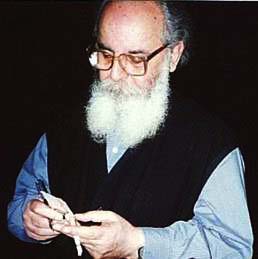
Mr.Houshang Ebtehaj ( Pen name : H. Alef. Sayeh )
In 1997, the Persian poetry group of Canbera had the privilege to invite
Mr.Houshang Ebtehaj ( Pen name : H. Alef. Sayeh ) to Canberra . This Iranian renowned poet who
resides in Germany had
been originally invited by The Iranian Community of Sydney to Australia
. The great Poet, Sayeh, was received with the warmest welcome by the Iranian
community of Canberra
. Sayeh recited several pieces of his own poems for about 80 people at that
evening.
This was the highest number of the Iranian population that population
that had ever gathered under one roof in Canberra .
The participants were touched by the beauty and spirituality of that
event that were experienced by almost every participan t t.
We were told that Mr. and Mrs. Ebtehaj had kept one of the best memories
of the all Persian Poetry Nights held in Australia .
Again this event was a result of a teamwork team work teamwork of the
Iranian community in Canberra
.
INVITING EMINENT SPECIALIST IN
IRANIAN HISTORY
Richard Nelson Frye , Emeritus
Professor at Harvard
In January 1998, Professor Richard Frye, was invited to deliver talks for
the Iranian Community in Canberra
.
Professor Frye was originally invited for a one week conference in
commemoration of the Iranian Festival called �Sadeh�. This conference was
sponsored and organised by The University of Sydney some interested Iranian
individuals.
Professor Richard Frye is one of the world's authorities in the field of
The Iranian Studies. He is the author of several books and has published
extensively about the Iranian history. He has lived in Iran for almost a decade during the seventies
70s teaching at the Shiraz University (formerly Pahlavi University
).
Following the suggestion by Hashem Etminan, coordinator of Professor
Frye's program at Canberra , a talk and group
discussions was held at �The Centre for Middle Eastern Studies of the Australian National University
�. Professor Amin Saikal Director of the Centre chaired this session.
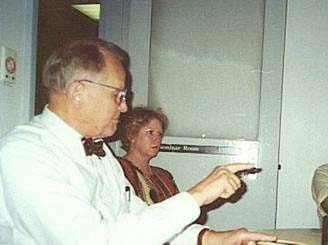
Professor Richard Frye at Australian National University
Professor Frye's talk for Iranian
Community at Canberra
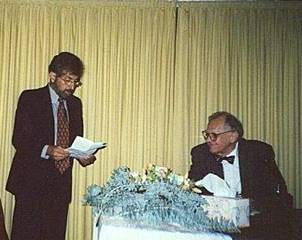
Dr Hashem Etminan, introducing
Professor Frye
The venue was t T he Tuggeranong Community Centre at Tuggeranong, in the Australian Capital Territory
. We again had an audience in excess of 80 Iranians and non - Iranians who
attended . at
Professor Frye's talk
Professor Frye delivered his talk both in Persian and in English. The
topic of his talk was a review of Persian history and literature with
emphasis on the significance of Persian poetry.
Professor Frye recited some poetry from different periods in Iran
. He praised the Persian poetry in stating that:
�Where else in World's literature one could find such fascinating and
fine art of poetry?�
His second part of talk was more focused on essential contribution of
Iranians in the World Civilization in diverse areas.
As a specialist of Sassanid period, Professor Frye elaborated some
aspects of the social structure during the end of Sassanid Empire. He stated
that the corruption of Zoroastrian clergymen and their influence in the Royal Court in
one hand and the differences between the social classes were the main
contributors of the decline of the powerful Persian
Empire . Social Class Structure
In the Sassanid time the division of the population became more apparent.
The distinguished classes were made up of the clerks, clergy, military and
nobles, while the ordinary classes included artisans, farmers and tradesmen.
The upper classes enjoyed a distinctive privileged life and were exempted
from the taxes and even from conscription in wars; all these burdens were
placed upon the second class second-class citizens.
The clergy's influence and aftermath events
Most clergymen mingled and intervened in daily life of people. As a
consequence of this power they gained huge wealth, and their influence was
extended in becoming an independent state within the state. He concluded that
this was the situation of Persian Empire
prior to its extinction. The clergy's influence pushed people to revolt.
Professor Frye encouraged the young Iranian generation who were present
in the audience to be proud to be originally from Iran . He noted that this is a
country with such a long history of battling for survival against all the
invaders. After all , the conquerors of Persia
( Iran
) have categorically been seen to have been absorbed by the Iranian culture.
In fact although the Iranian s had apparently lost the battle but they had
won the war by their dominant culture.
The feedbacks again were overwhelming and the n ever on ending number s
of questions were answered patiently by Professor Frye both in Persian (with
a pleasant accent) and in English.
|






